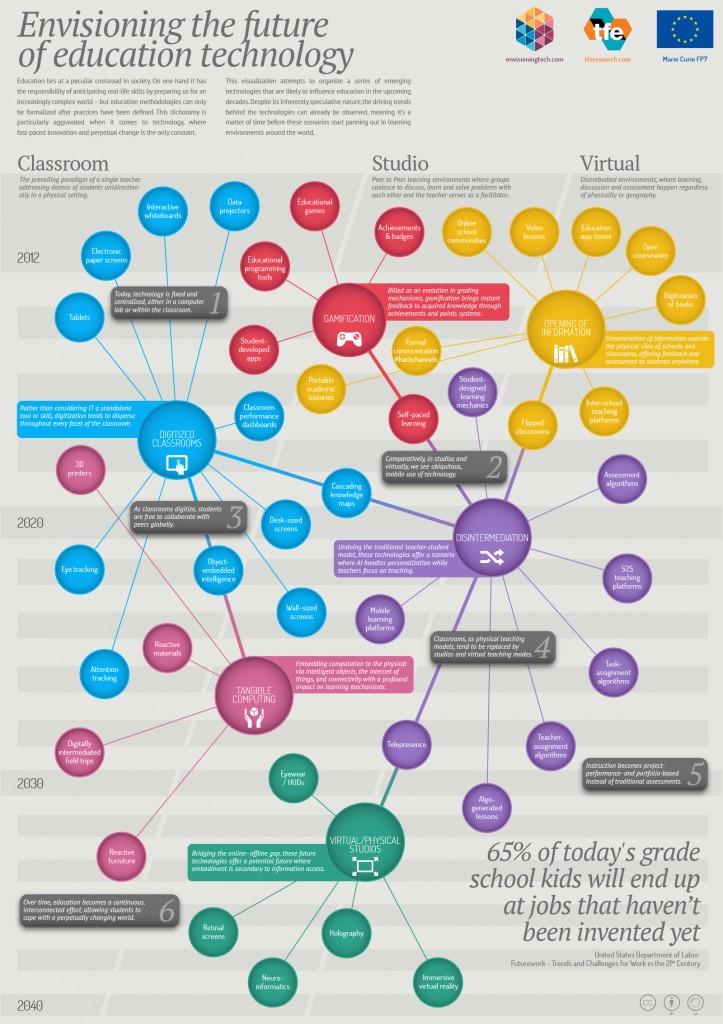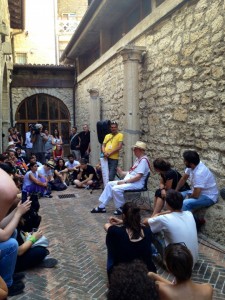I like writing position papers! This is the second submission for the Alpine Redezvous workshop on the topic of TEL, the Crisis and the Response. This position paper is co-written with Dirk Stieglitz and Ilona Buchem.
We are aware of the increasing concerns about the commodification, monetarisation and privatization of education and academic labour. We also acknowledge the concern that the current mode of [neo-liberal] late-capitalism relies on “the continuous extension and validation of the infrastructure and the optimistic discourses of the new information technologies” (Hoofd, 2010)
However, rather than focus on concerns about the role of technology in the organisation and control of the educational infrastructure, in this position paper we which to examine the potential – and potential contradictions – of technology for learning. This in turn, leads to a focus on pedagogy, defined here as the theory and practice of teaching and learning. Technology is not pedagogically neutral – all technology enhances or hinders particular approaches to learning.
It is not hard to criticize the uses of educational technology in institutions. In its earlier phases technology was used to manage learners rather than facilitate learning. In its latter phase technology is being deployed both to commodify and monetarize knowledge (and the academic labour which produces such knowledge) and at the same time to sell education as just another consumer product (hence the present hype around so called learning analytics). Almost inevitably, attempts to develop an alternative ecology or milieu and an alternative pedagogy – such as MOOCs – are being absorbed by the dominant culture. Interestingly, in this regard, we can perceive the contradiction between an understanding of academic staff who wish to open up new horizons for learning to students with the concerns of the students who wish only to receive the necessary knowledge to achieve the credentials for which they believe they have paid. This in turn reinforces push technologies to support funnel delivery of learning objects to receivers (clients or customers). And despite the hype about the uses of technology by digital residents, repeated surveys have shown very limited use of social technologies by students to create, rather than consume digital artefacts and knowledge.
However, there is an alternative perspective. The almost indecent rush to commodify academic knowledge through the use of technology[1] may, to some extent, be driven by a realization that knowledge has escaped from the walled garden of the academy.
We would argue that the education systems grew in response to the needs of industrial capitalisms (in this respect it is informative to note that many Victorian schools in the UK were deigned to look like factories and were organised on a factory model). Despite the efforts of communities and organisations such as the Miners Hall, the Workers Educational Association and the Mechanics Institutes (and similar bodies and movements in other countries than the UK), access to education – and knowledge – was largely a monopoly of the education system, which in turn was ideologically driven by the needs of capitalist enterprises.
Despite the efforts of institutions and others – including publishers – to maintain control of knowledge, the internet allows an abundance of access to knowledge and learning, especially through informal and self managed learning. In a study we undertook of the use of information and communication for learning in Small and Medium Enterprises in six countries in Europe, in 106 case studies we found only one instance of the use of ICT for formal learning. Yet we found numerous uses of technology for informal learning (although often the users did not recognize this as learning themselves). We found:
– the web was the platform for learning
– in most cases the managers did not know such learning was happening
– there was more likelihood of learning taking place where people had more control of work processes
– learning was sometimes driven by just in time needs stemming from the work but was often driven by learners’ interests
– learners had little interest in formal accreditation or credentials and no interest in assessment
Such learning often took place through contacting friends or through participating in informal, online communities of practice. Support for learning was through peers or those who Vygotsky called a More Knowledgeable Other and learning was largely self-directed.
Learning was heavily contextual, depending on both the subject and level of learning, the nature of the problem or the culture of the community.
Through a combination of the physical workplace and subject based culture and the culture of the online interactions, users were making new meanings for their own practice. This chimes with Bakhtin’s reasoning that others or other meanings are required for any cultural category to generate meaning and reveal its depths.
“Contextual meaning is potentially infinite, but it can only be actualized when accompanied by another (other’s) meaning, if only by a question in the inner speech of the one who understands. Each time it must be accompanied by another contextual meaning in order to reveal new aspects of its own infinite nature (just as the word reveals its meanings only in context). (Bakhtin, 1986, pp. 145–146).”
Akkerman and Bakker suggest that boundary crossing and the understanding of learning as a process that involves multiple perspectives and multiple parties is “different from most theories on learning that, first, often focus on a vertical process of progression in knowledge or capabilities (of an individual, group, or organization) within a specific domain and, second, often do not address aspects of heterogeneity or multiplicity within this learning process.”
Akkerman and Bakker advance “four dialogical learning mechanisms of boundaries:
- identification, which is about coming to know what the diverse practices are about in relation to one another;
- coordination, which is about creating cooperative and routinised exchanges between practices;
- reflection, which is about expanding one’s perspectives on the practices; and,
- transformation, which is about collaboration and co-development of (new) practices.”
The interesting point here is the relation to practices, and to dialogical learning processes, as opposed to the reified and top down nature of knowledge acquisition through institutional online learning and traditional TEL.
We suggest that if the TEL community is to contribute towards a response to the crisis, that response requires a move from a focus on formal knowledge transmission through educational technology controlled by institutions, to a perspective of supporting community knowledge acquisition and self directed learning focused on practice. It equally requires a change in developmental approaches with technology co-developed with the communities of practice. Interestingly, it could be argued that such a change, although explicitly opposed to the use of TEL to commodify formal education, would provide a better social and economic use of technology in existing economies.
References
Akkerman, S. F., & Bakker, A. (2011). Boundary crossing and boundary objects. Review of Educational Research, 81, 132-169, http://rer.sagepub.com/cgi/reprint/0034654311404435v1?ijkey=4LKMx60v0wQzc&keytype=ref&siteid=sprer
Bakhtin, M. (1986). From notes made in 1970-71 (V. McGee, Trans.). In C. Emerson, & M. Holquist (Eds.), Speech genres & other late essays (pp. 132–158). Austin: University of Texas Press.
Hoofd, I. (2010), The accelerated university: Activist- academic alliances and the simulation of thought, in ephemera 2010 www.ephemeraweb.org volume 10(1): 7-24



